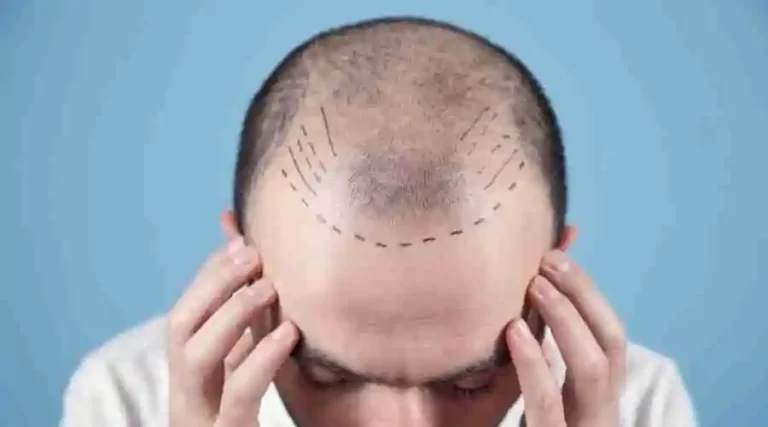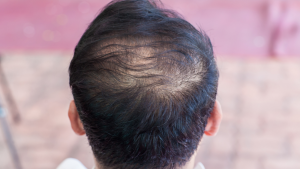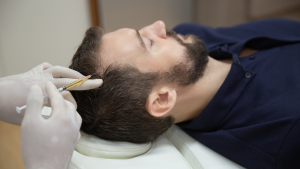There are so many myths and stories about what causes baldness that it can be hard to know where to start debunking them. People will find something to blame. Since we can’t cover every possible myth about hair loss, we’ll just talk about the four biggest ones.
Stress on the mind and harm to the body
People often believe, but wrongly, that physical trauma and mental stress, like pain and fear, can cause hair loss. Men tell us all the time that they didn’t start losing their hair until their daughter started dating, they started having trouble with money, or they got a divorce. Still, some people swear that their hair loss started after they got a blow or injury to the head, usually in an accident. Do you agree with these reasons? No. Even though stress can make hair loss happen faster, especially in women, it is not the main reason.
From a psychological point of view, what these people think caused their hair loss is actually a delayed reaction to a process that had already started. In other words, their hair started to thin before the accident or before their daughter started dating. Only afterward, when the trauma or stress had made them more aware, did the men start to notice that their hair was getting thinner. This is a normal psychological response.
The Broken Highway System
One of the most common myths about hair loss is called the “faulty freeway system.” This myth is still taught in some barber and beauty schools. This theory is based on the fact that the very top of the head gets less blood flow than the lower parts of the scalp. Because of this supposed “flaw” in the circulatory system, also called the “broken freeway system,” the hair follicles don’t get the nutrients they need, which lets “toxins” build up. The hair then dies from lack of food and falls out. The theory also says that wearing a hat or other headwear, which is necessary for some jobs, cuts off circulation to the head, making the already low blood supply to the head even worse. What happened? Loss of hair.
The scalp gets its blood supply from branches of the left and right carotid arteries, which go up from the heart, curve around the ears, and continue up like the branches of a tree to the top of the head. So, if baldness was caused by the circulatory system, all men and women would start to lose hair in a central line that goes from the top of the head to the frontal hairline and gets wider as it gets closer to the ears. Clearly, this is not how things work. On the other hand, the thinning of hair just above the temples is the first sign of common baldness in most men. This makes the well-known triangle-shaped or “V”-shaped recesses on either side of the hairline, which are called temporal recessions. This area, on the other hand, gets more blood than the very top of the head, but this is where most people start to lose their hair.
There are other things that show that the circulatory system and hair loss are not linked. For example, as people get closer to middle age (35 to 55), they tend to grow hair in their eyebrows, ears, and noses that they don’t want. How could something like this be caused by the circulatory system? Is it possible that all men’s ears, noses, and eyebrows get more blood all of a sudden in their middle years for no clear reason? It could happen, but it’s not likely.
In 1955, Dr. Norman Orentreich did an experiment that was a final blow to the theory that there wasn’t enough blood. He took a 4-millimeter hair-bearing graft from the back of a patient’s head with intact follicles and a 4-millimeter bald graft from the top of the same patient’s head where a lot of hair had been lost. Then, Dr. Orentreich switched the two grafts, putting the one with hair where the one without hair had been and the other way around. After watching these grafts for a few months, Dr. Orentreich noticed that the “hairy” graft grew well in the vast space of baldness, while the “bald” graft stayed bald in a sea of hair! If blood flow affects hair loss and/or growth, the hair on the graft on the top of the head should have fallen out. The bald graft that was put on the back of the head, on the other hand, should have grown hair.
Cleanliness Comes After Hairiness
This theory says that too much oil, air pollution, sebum, and dead cells get stuck around the hair shaft. This kills the hair by suffocating it and making it unable to grow. The obvious question then is, “Why does hair continue to grow in other parts of the head, especially on the sides and back?” The trichologist, or hair clinic expert, may say that these hairs grow in a downward direction, which makes the dangerous buildup slide down the hairs and away from the shaft and follicle, protecting the hair. But this is not true at all.
The idea that a dirty scalp causes hair loss doesn’t make sense because there are many clean men who are bald and many dirty men who have full heads of hair. If this theory were true, both men and women would lose their hair quickly in countries where people don’t have many chances or resources to take care of themselves. Nothing could be further from the truth, of course. If the whole scalp is dirty, wouldn’t it all fall out at once?
Taking care of your scalp and hair by doing things like shampooing every day is a good grooming habit that will make your hair look better. But it won’t stop hair from falling out or make it grow back.
What you eat affects you.
The “you are what you eat” or “vitamin supplement” theory says that men who lose their hair don’t get enough of certain nutrients, which kills the hair follicles. This theory says that taking vitamin and mineral supplements, like zinc, the amino acid cysteine, and the B-complex vitamin biotin, is the best way to stop baldness.
A trichologist at a hair salon and deceptive ads will say that lab research has shown that hair, which is mostly made of protein, needs certain vitamins, minerals, and amino acids to grow. Most of the time, the argument is that the average American man’s diet lacks these important nutrients. Because of this, he is going bald.
Can hair loss be caused by not getting enough of certain nutrients? Yes, but the lack of food must be so bad that the person is literally starving to death. Nutritional deficiencies, like short-term low levels of magnesium or zinc, can happen to healthy people in the United States, but they are not the same as clinical starvation. Also, clinical starvation does not and cannot cause the patterns of hair loss that are known as male pattern baldness. Instead, it causes hair loss that is spread out over the whole scalp. Also, hair loss is not the only sign of clinical malnutrition, and it is usually one of the last ones to show up. Conditions or diseases of the teeth, gums, skin, and nails, as well as conditions or diseases of the internal organs, are among the other symptoms. So, if you have diffuse hair loss with no pattern and no other signs of acute clinical starvation, it is safe to assume that your hair loss is not caused by a lack of nutrients.
Taking Lessons from the Inuit
The Inuit people, who live in the Arctic, maybe the best example of a culture that disproves the common myths about baldness. Inuit men don’t wash their hair very often, and most of the time they wear hats. They also put whale and fish oils on their hair to make it shine, which in their culture is a good thing. Also, their limited diet, which is mostly protein and fat, doesn’t have enough different foods to be considered balanced. This is shown by the fact that the Inuit culture has a low life expectancy. The average Inuit man lives to be sixty years old.
According to all the myths about baldness, Inuit men should have an unusually high rate of baldness because they have poor circulation because it’s cold, less blood supply because they wear hats, a sebum-clogged scalp, and a diet that doesn’t have enough essential vitamins. But like other people of the same race, Inuit men have a much lower chance of going bald than the average Caucasian man.





